The Microsoft Surface Laptop 2 Review: Surface Essentials
by Brett Howse on March 28, 2019 8:00 AM EST- Posted in
- Laptops
- Microsoft
- Surface
- Surface Laptop
- KBL-R
- Surface Laptop 2
Battery Life
By Ultrabook standards, the 47.5 Wh battery capacity in the Surface Laptop 2 is on the light side, as some of the competition can offer 60 Wh or so. But Microsoft tends to focus quite a bit on power usage instead of raw capacity, and as a result can eke out extra battery life through other means. The battery is only slightly larger than the 45 Wh in the Surface Pro 6, and it performed well in our battery rundown tests.
To test the battery life, we calibrate displays to 200 nits to make the test as even as possible, and then run through several workloads.
2013 Light
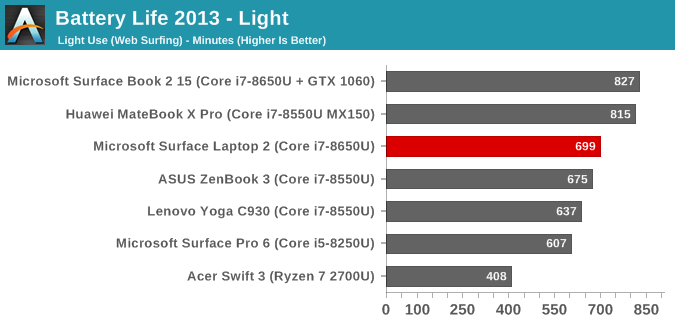
Our lightest test is our oldest, which cycles four webpages per minute. The scripting isn’t a very big task for modern processors. Despite the smaller battery, the Surface Laptop 2 lasted for over 11.5 hours, which is fantastic.
2016 Web

Our web test involves a lot more work for the CPU, and as such the results are generally quite a bit lower than our older light test, and that is the case here again with the Surface Laptop losing over an hour of runtime compared to the light test, but it still came in well above any other laptop we’ve tested, offering over 10.5 hours of runtime.
Movie Playback
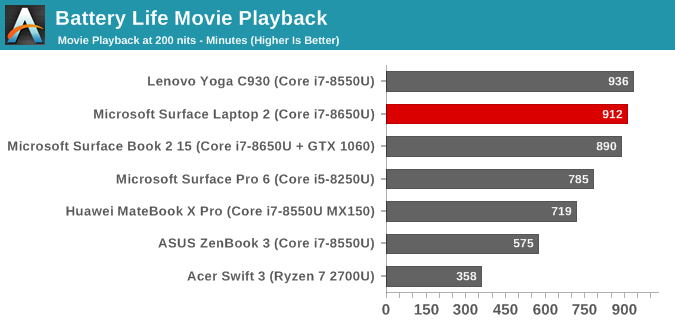
Media playback allows the CPU to offload work to fixed function hardware in the media block, which allows most of the processor to go to sleep. The Surface Laptop was able to play back a local movie file for over 15 hours, which is amazing considering the battery capacity here.
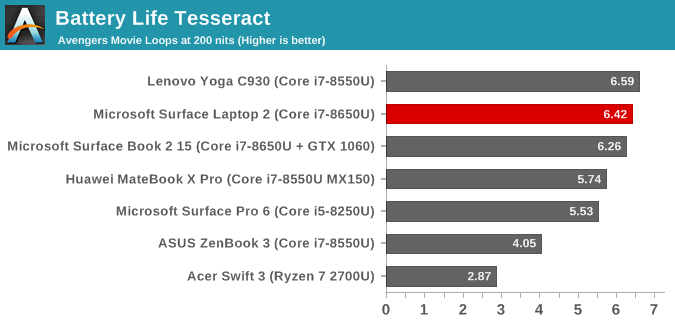
Our Tesseract score puts the movie playback into a more usable number. The runtime is divided by the length of a long movie (The Avengers) to get a result in terms of how many movies you can watch in a row. The Surface Laptop 2 is ready for any movie marathon you’re after.
Normalized Results

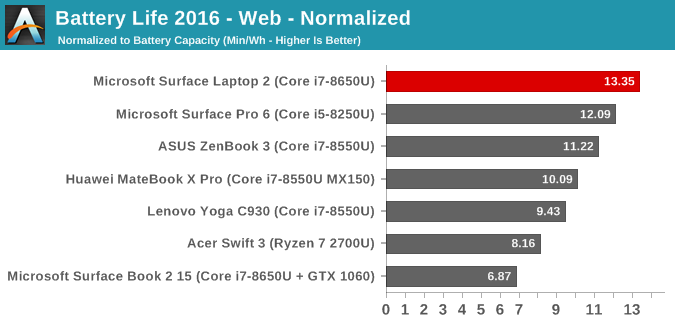
By removing the battery capacity from the equation, we can take a look at the efficiency of each device. The Surface Laptop 2 outperforms all other laptops we’ve tested here. Microsoft has put a tremendous amount of effort in the getting power consumption in check across their lineup, and the lower display density of the Surface Laptop 2 puts it at the top of their devices, as well as the top of any laptop we’ve tested. It is a truly impressive result.
Charge Time
Microsoft ships the Surface Laptop 2 with a 44 Watt power supply, and in typical Surface fashion it offers an incredibly useful USB charging port built into the brick. The charger connects via the Surface Connect port, which is the same proprietary magnetic connector Microsoft has been using since the introduction of the Surface Pro 3. It’s a great connector, it’s easy to connect, and it offers a light on the side so you know whether or not it’s charging or not. The only thing missing is it would be nice to have the USB-C port for charging as well, which would make travel even easier.
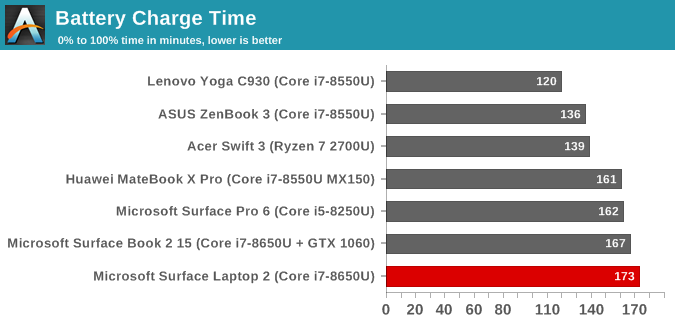
The Surface Laptop 2 isn’t particularity quick at charging, but it’s within a few minutes of the other Surface devices. Microsoft doesn’t seem to want to charge the battery too quickly, which may help with longevity, but thanks to the efforts they’ve put into the battery consumption, they likely don’t need to put as much weight on charging.










59 Comments
View All Comments
sorten - Thursday, March 28, 2019 - link
If I absolutely needed a laptop today I'd probably pick up a used one so I could wait for the Ice Lake CPUs from Intel this fall. It would be a shame to buy such nice hardware only to find yourself two significant generations behind within 6 months.yankeeDDL - Thursday, March 28, 2019 - link
I hope you're right. Intel has been caught sleeping, and the improvements since SkyLake have been, frankly, anecdotal. It seems that AMD, by making a small core, designed from the ground up to work in tandem with other cores, has a much more effective/scalable architecture. So a 4-core, 8-thread CPU from AMD, while providing slightly lower IPC, today, is much more effective than a 4-core, 8-thread CPU from Intel.Let's see if ICL brings real benefits. The 10nm node should help a lot.
smilingcrow - Thursday, March 28, 2019 - link
"So a 4-core, 8-thread CPU from AMD, while providing slightly lower IPC, today, is much more effective than a 4-core, 8-thread CPU from Intel."I thought AMD currently has lower IPC + lower clock speeds so how exactly are they more effective?
With Ryzen3/Zen 2 due in the summer this may change but for now AMDs advantage is more cores per buck.
niva - Thursday, March 28, 2019 - link
I'm assuming he meant in terms of price/core, but that's just a guess.Doesn't AMD have a big problem with power consumption in mobile CPUs though? I've read that the AMD laptops out now suffer from big power drain even if performance wise they're equivalent or batter than the Intel chips at the same price range.
Irata - Friday, March 29, 2019 - link
Supposedly in idle only, but I do not really see that on my Matebook. Then again, I do not let it sit idling for hours on battery since it boots so quickly that there is no reason for that.In normal use (web / video), the battery indicator does not move much at all.
What many forget is that even with Intel based laptops, there are sometimes big differences between models or manufacturer, depending on the battery size and how well they configured their laptop. The ones that aren't well done are not the ones you usually see in comparison tests though (as there are more models to pick from vs. AMD based ones).
lightningz71 - Monday, April 1, 2019 - link
Their big problem was definitely low power states management on the 2X00u series of chips. The 3x00 series chips that are now hitting the market make up a lot of ground in that regard, both with the chips themselves and better bios/uefi implementations by the vendors that are building the systems. Add in the fact that AMD has finally decided to take the lead on providing a stable, performant drivers for the video section of the chips, and you can largely ignore the abysmal efforts of the vendors themselves to provide quality, updated drivers themselves.For the money, some of the low end AMD 2x00u series laptops gave you MUCH more bang for your buck than the equivalent intel based offerings. The few limitations that people who purchased them did come across could be overcome through software tools by those that it actually mattered to (power and performance management profiles could be tweaked by certain software tools that allowed systems to maintain higher boost states longer and better manage their thermals).
I can't wait to see some of the more thorough write-ups on the latest 3x00h series laptops that are fast enough in both core performance and graphics performance to go up against comparable intel based machines that also include an Nvidia MX1xx series dGPU with an i5. They should technically be less expensive, offer similar performance and be more power friendly when pushed to their limits. This isn't to say that they won't have their flaws, just that, dollar for dollar, on the low end, you'll get more with the AMD system.
Manch - Friday, March 29, 2019 - link
Superior SMTsmilingcrow - Friday, March 29, 2019 - link
IPC includes the whole chip performance so they are still behind.Zen currently makes sense to me if you want 8 or more cores so hopefully with Zen 2 they will compete from 4 cores upwards.
Manch - Monday, April 1, 2019 - link
IPC refers to the perf of a single core usually. Generally has an advantage of about 8-10%. That advantage disapears when using SMT/HT. AMD has the more efficient design so it makes up for that 10% deficit. Throw in multiple core and it starts to win. TBS even now a lot of software is optimized still for Intel but thats changing rapidly. Intel still has a clockspeed advantage. Where as Zen has a pretty hard wall @4.3, Intel can get on down the road a good bit faster. Especially with 4 core chips. I dont think that advantage will last too much longer. Between the mitigations from ME/SPec, and lack of new architecture, Intel seem to be pushing cores over HT now to keep its advantage short term. AMD put out a competitive chip, Intel has yet to fire back like it did with Core against Athlon XPs(Those were the days!) Theyre just stretching their long in the tooth Core. Something is waiting in the wings though.smilingcrow - Monday, April 1, 2019 - link
From what I've seen a 6C/12T Intel beats a similar spec AMD easily.I've read that AMD's HT gives a bigger boost than Intel's but that still isn't enough for it to catch up due to it being too far behind in other areas.
So it's about as meaningful in the real world as a purely synthetic benchmark.
That should change soon with Zen 2 so there will be no need to live the life of a fantasist then.